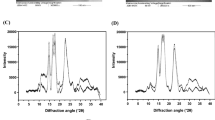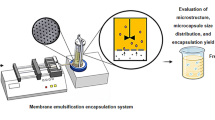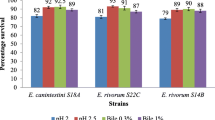Abstract
Microencapsulation is an optimistic method for the delivery of live microbial cells through different food products. In this study, riboflavin-producing probiotic strain Lactiplantibacillus plantarum MTCC 25,432 was encapsulated using a spray drying technique with different wall materials including Inulin, maltodextrin (MD), and MD + Inulin (1:1). The obtained spray dried powder was investigated for probiotic viability, encapsulation efficiency, particle size, water activity, moisture content, hygroscopicity, bulk and tapped densities, storage stabilities, Fourier transform infrared spectroscopy (FTIR) and thermogravimetric analysis (TGA). Besides this, the viability of the free and encapsulated probiotic cells was tested under simulated gastric and intestinal fluid conditions. In the results, microcapsules produced with the combination of MD + Inulin showed higher dry powder yield (36.5%) and viability of L. plantarum MTCC 25,432 (7.4 log CFU / g) as compared with individual coating materials. Further characterization revealed that MD + Inulin microcapsules are spherical (3.50 ± 1.61 μm in diameter) in shape with concavities, showed the highest encapsulation efficiency (82%), low water activity (0.307), moisture content (3.67%) and good survival ability at low pH (pH 2.0 and 3.0), high bile salt concentrations (1.0% and 2.0%), and long storage conditions. No differences in FTIR spectra were observed among the tested samples. However, TGA showed enhanced thermal stability of probiotic-loaded microcapsules when MD + Inulin was used together. In conclusion, MD + Inulin could be a potential encapsulation material for riboflavin-producing probiotic bacteria L. plantarum MTCC 25,432.







Similar content being viewed by others
References
Hill C, Guarner F, Reid G et al (2014) Expert consensus document: the international scientific association for probiotics and prebiotics consensus statement on the scope and appropriate use of the term probiotic. Nat Rev Gastroenterol Hepatol 11:506–514. https://doi.org/10.1038/nrgastro.2014.66
Plaza-Diaz J, Ruiz-Ojeda FJ, Gil-Campos M, Gil A (2019) Mechanisms of action of Probiotics. Adv Nutr 10:S49–S66. https://doi.org/10.1093/advances/nmy063
Ahire JJ, Jakkamsetty C, Kashikar MS et al (2021) In vitro evaluation of probiotic properties of Lactobacillus plantarum UBLP40 isolated from traditional indigenous fermented food. Probiotics Antimicrob Proteins 13:1413–1424. https://doi.org/10.1007/s12602-021-09775-7
Guarino MPL, Altomare A, Emerenziani S et al (2020) Mechanisms of action of prebiotics and their effects on gastro-intestinal disorders in adults. Nutrients 12:1–24. https://doi.org/10.3390/nu12041037
De Vrese M, Schrezenmeir J (2008) Probiotics, prebiotics and synbiotics. Adv Biochem Eng Biotechnol 111:1–66. https://doi.org/10.1201/b15561-2
Hamasalim HJ (2016) Synbiotic as feed additives relating to animal health and performance. Adv Microbiol 06:288–302. https://doi.org/10.4236/aim.2016.64028
Nezamdoost-Sani N, Khaledabad MA, Amiri S, Mousavi Khaneghah A (2023) Alginate and derivatives hydrogels in encapsulation of probiotic bacteria: an updated review. Food Biosci 52:102433. https://doi.org/10.1016/j.fbio.2023.102433
Rodrigues FJ, Cedran MF, Bicas JL, Sato HH (2020) Encapsulated probiotic cells: relevant techniques, natural sources as encapsulating materials and food applications – A narrative review. Food Res Int 137. https://doi.org/10.1016/j.foodres.2020.109682
Ray S, Raychaudhuri U, Chakraborty R (2016) An overview of encapsulation of active compounds used in food products by drying technology. Food Biosci 13:76–83. https://doi.org/10.1016/j.fbio.2015.12.009
Rajam R, Anandharamakrishnan C (2015) Microencapsulation of Lactobacillus plantarum (MTCC 5422) with fructooligosaccharide as wall material by spray drying. Lwt 60:773–780. https://doi.org/10.1016/j.lwt.2014.09.062
Koh WY, Lim XX, Tan TC et al (2022) Encapsulated probiotics: potential techniques and coating materials for non-dairy food applications. Appl Sci 12. https://doi.org/10.3390/app121910005
Hadzieva J, Mladenovska K, Crcarevska MS et al (2017) Lactobacillus casei encapsulated in soy protein isolate and alginate microparticles prepared by spray drying. Food Technol Biotechnol 55:173–186. https://doi.org/10.17113/ftb.55.02.17.4991
Arepally D, Reddy RS, Goswami TK (2020) Encapsulation of Lactobacillus acidophilus NCDC 016 cells by spray drying, characterization, survival after in vitro digestion, and storage stability. Food Funct 11:8694–8706. https://doi.org/10.1039/d0fo01394c
Shams R, Singh J, Dash KK et al (2022) Effect of maltodextrin and soy protein isolate on the Physicochemical and Flow Properties of Button mushroom powder. Front Nutr 9:1–14. https://doi.org/10.3389/fnut.2022.908570
Ozcelik M, Kulozik U (2023) The role of maltodextrin concentration in maintaining storage stability of dried fruit foams texturized using plant protein–polysaccharide blends. Foods 12 https://doi.org/10.3390/foods12081673
Rodríguez-Huezo ME, Durán-Lugo R, Prado-Barragán LA et al (2007) Pre-selection of protective colloids for enhanced viability of Bifidobacterium bifidum following spray-drying and storage, and evaluation of aguamiel as thermoprotective prebiotic. Food Res Int 40:1299–1306. https://doi.org/10.1016/j.foodres.2007.09.001
Favaro-Trindade CS, de Matos Junior FE, Okuro PK et al (2021) Encapsulation of active pharmaceutical ingredients in lipid micro/nanoparticles for oral administration by spray-cooling. Pharmaceutics 13:1–14. https://doi.org/10.3390/pharmaceutics13081186
Bhushan B, Sakhare SM, Narayan KS et al (2021) Characterization of riboflavin-producing strains of Lactobacillus plantarum as potential probiotic candidate through in vitro assessment and principal component analysis. Probiotics Antimicrob Proteins 13(2):453–467. https://doi.org/10.1007/s12602-020-09696-x
Bhushan B, Kumkum CR, Kumari M et al (2020) Soymilk bio-enrichment by indigenously isolated riboflavin-producing strains of Lactobacillus plantarum. Lwt Food Sci Technol 119:108871. https://doi.org/10.1016/j.lwt.2019.108871
Narayan KS, Gaurkhede S, Sharma V et al (2021) Technological and functional assessment of riboflavin enriched probiotic soycurd. Fermentation 7. https://doi.org/10.3390/fermentation7020047
Kumar V, Amrutha R, Ahire JJ, Taneja NK (2022) Techno-functional assessment of riboflavin-enriched yogurt-based fermented milk prepared by supplementing riboflavin-producing probiotic strains of lactiplantibacillus plantarum. Probiotics Antimicrob Proteins. https://doi.org/10.1007/s12602-022-10026-6
Sarabandi K, Peighambardoust SH, Sadeghi Mahoonak AR, Samaei SP (2018) Effect of different carriers on microstructure and physical characteristics of spray dried apple juice concentrate. J Food Sci Technol 55:3098–3109. https://doi.org/10.1007/s13197-018-3235-6
Tirta GD, Martin L, Bani MD et al (2023) Spray drying encapsulation of Pediococcus acidilactici at different inlet air temperatures and wall material ratios. Foods 12. https://doi.org/10.3390/foods12010165
Fritzen-Freire CB, Prudêncio ES, Pinto SS et al (2013) Effect of microencapsulation on survival of Bifidobacterium BB-12 exposed to simulated gastrointestinal conditions and heat treatments. LWT - Food Sci Technol 50:39–44. https://doi.org/10.1016/j.lwt.2012.07.037
Bhagwat A, Bhushette P, Annapure US (2020) Spray drying studies of probiotic Enterococcus strains encapsulated with whey protein and maltodextrin. Beni-Suef Univ J Basic Appl Sci 9. https://doi.org/10.1186/s43088-020-00061-z
Xu M, Gagné-Bourque F, Dumont MJ, Jabaji S (2016) Encapsulation of Lactobacillus casei ATCC 393 cells and evaluation of their survival after freeze-drying, storage and under gastrointestinal conditions. J Food Eng 168:52–59. https://doi.org/10.1016/j.jfoodeng.2015.07.021
Rajam R, Subramanian P (2022) Encapsulation of probiotics: past, present and future. Beni-Suef Univ J Basic Appl Sci 11:46. https://doi.org/10.1186/s43088-022-00228-w
Baer DR, Engelhard MH, Johnson GE et al (2013) Surface characterization of nanomaterials and nanoparticles: important needs and challenging opportunities. J Vac Sci Technol A Vacuum Surfaces Film 31:050820. https://doi.org/10.1116/1.4818423
Barro NPR, da Silva LM, de Hassemer G S, et al (2021) Microencapsulation of probiotic Lactobacillus helveticus with different wall materials by spray drying. Biointerface Res Appl Chem 11:11221–11232. https://doi.org/10.33263/BRIAC114.1122111232
Fritzen-Freire CB, Prudêncio ES, Amboni RDMC et al (2012) Microencapsulation of bifidobacteria by spray drying in the presence of prebiotics. Food Res Int 45:306–312. https://doi.org/10.1016/j.foodres.2011.09.020
Arepally D, Reddy RS, Goswami TK (2020) Studies on survivability, storage stability of encapsulated spray dried probiotic powder. Curr Res Food Sci 3:235–242. https://doi.org/10.1016/j.crfs.2020.09.001
Looi YF, Ong SP, Julkifle A, Alias MS (2019) Effects of pretreatment and spray drying on the physicochemical properties and probiotics viability of Moringa (Moringa oleifera Lam) leaf juice powder. J Food Process Preserv 43:1–15. https://doi.org/10.1111/jfpp.13915
FAO/WHO (2002) Guidelines for the evaluation of probiotics in food. 1–11. https://www.fao.org/3/a0512e/a0512e.pdf. Assesed 19 April 2023
Saénz C, Tapia S, Chávez J, Robert P (2009) Microencapsulation by spray drying of bioactive compounds from cactus pear (Opuntia ficus-indica). Food Chem 114:616–622. https://doi.org/10.1016/j.foodchem.2008.09.095
Bustamante M, Laurie-Martínez L, Vergara D et al (2020) Effect of three polysaccharides (inulin, and mucilage from chia and flax seeds) on the survival of probiotic bacteria encapsulated by spray drying. Appl Sci 10:1–17. https://doi.org/10.3390/app10134623
Praepanitchai OA, Noomhorm A, Anal AK, Potes ME (2019) Survival and behavior of encapsulated probiotics (Lactobacillus plantarum) in calcium-alginate-soy protein isolate-based hydrogel beads in different processing conditions (pH and temperature) and in pasteurized mango juice. Biomed Res Int 2019. https://doi.org/10.1155/2019/9768152
Chandramouli V, Kailasapathy K, Peiris P, Jones M (2004) An improved method of microencapsulation and its evaluation to protect Lactobacillus spp. in simulated gastric conditions. J Microbiol Methods 56:27–35. https://doi.org/10.1016/j.mimet.2003.09.002
Kailasapathy K (2006) Survival of free and encapsulated probiotic bacteria and their effect on the sensory properties of yoghurt. Lwt Food Sci Technol 39:1221–1227. https://doi.org/10.1016/j.lwt.2005.07.013
Funding
The work was funded by the National Institute of Food Technology Entrepreneurship and Management (NIFTEM), Sonepat, India.
Author information
Authors and Affiliations
Contributions
Taneja NK and Vikram contributed to the study’s conception and design. Material preparation, data collection, and analysis were performed by Vikram, Amrutha and Sahil Nain. The first draft of the manuscript was written by Vikram. Ahire JJ edited the manuscript extensively and wrote the final draft. Taneja NK reviewed and approved the draft. All authors read and approved the final manuscript.
Corresponding author
Ethics declarations
Competing interests
Ahire JJ was employed by Dr. Reddy’s Laboratories Limited. Dr. Reddy’s Laboratories had no direct and indirect role in the study design/analysis/writing of this article. Other authors have no conflict of interest to declare.
Ethics Approval
This study does not contain any work related to the participation of humans and/or animals.
Additional information
Publisher’s Note
Springer Nature remains neutral with regard to jurisdictional claims in published maps and institutional affiliations.
Rights and permissions
Springer Nature or its licensor (e.g. a society or other partner) holds exclusive rights to this article under a publishing agreement with the author(s) or other rightsholder(s); author self-archiving of the accepted manuscript version of this article is solely governed by the terms of such publishing agreement and applicable law.
About this article
Cite this article
Kumar, V., Ahire, J.J., R., A. et al. Microencapsulation of riboflavin-producing Lactiplantibacillus Plantarum MTCC 25,432 and Evaluation of its Survival in Simulated Gastric and Intestinal Fluid. Probiotics & Antimicro. Prot. (2023). https://doi.org/10.1007/s12602-023-10115-0
Accepted:
Published:
DOI: https://doi.org/10.1007/s12602-023-10115-0




